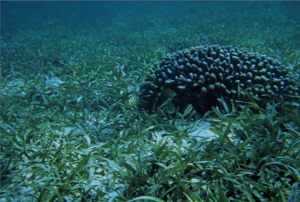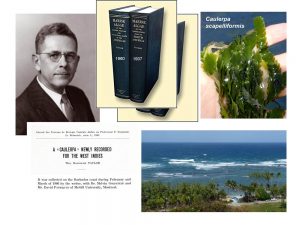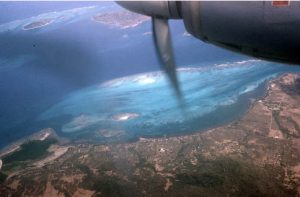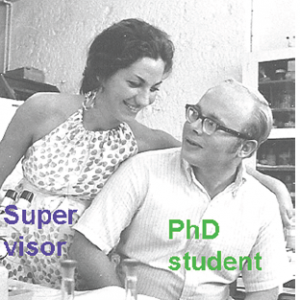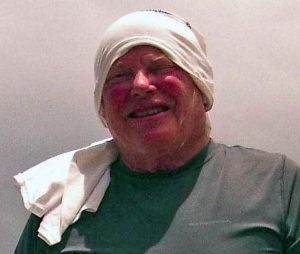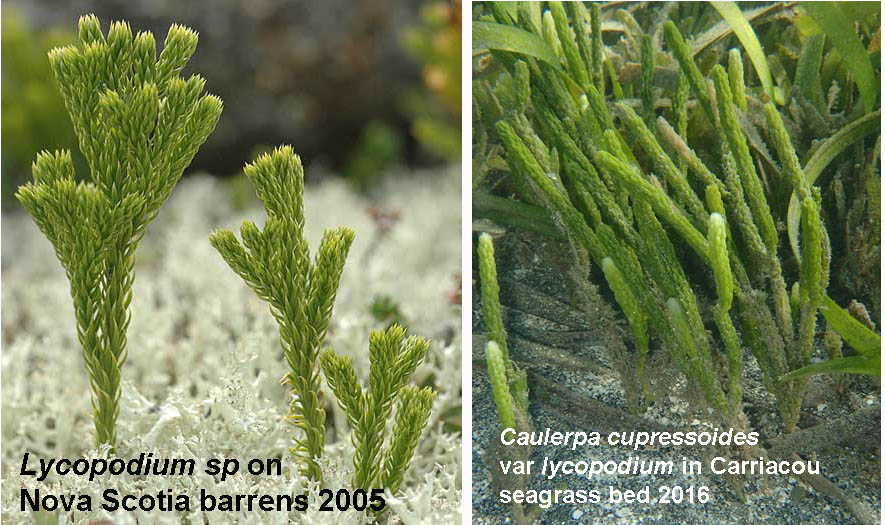How do Caribbean seagrasses relate to the forests of Nova Scotia?
Jan 11, 2019
nsforestnotes.ca may be a little slow on the uptake for a while. I highly recommend Woods and Waters Nova Scotia (Mike Parker’s public Facebook Page) as a place to check in on to see what’s happening, also Mike hosts civil discussion of NS forest and forestry issues.
I have to say, the back and forth over the last 3 weeks or so has been hard to keep up with even though I am “capturing” only a fraction it. Regardless, I will be able to do less for at least the next 3 months, possibly to the relief of some.

nsforestnotes.ca is getting more attention than I anticipated, and questions will be asked..”where did he go” and “who this guy anyway?”, the latter has already been asked. So I figured I better get my version out, warts and all. It’s NOT required reading!
Leaving aside the personal, there are two things that can keep me awake at night or enter my dreams when I am asleep: forests and forestry in NS; and seagrasses in the Caribbean. The former – the keeping me awake at night part of it, is pretty recent. The seagrasses go back a lot longer.
As an academic at a university (retired since 2008), I have been fortunate to have a lot of freedom to pursue my interests…as long you maintain a fairly high level of research and teaching you are OK. You have even more freedom once you get tenure, like the senators in Ottawa. That can be abused, but I can think of only one out of about 50 in my department (Biology) who came anywhere near that. For most, in this competitive era, it is hard to give up the addiction to the work work work that you need to do to maintain grants etc and to get tenure, and once you get there, you just keep on going. Many don’t stop even after retirement. I guess I haven’t (my spouse tells me that); it’s just that I am out of the publish or perish aspect, and out in the field rather than in a lab, although still too much on the computer.
So to get where I am going..my graduate work was in Marine Sciences at McGill, a MSc to do with Arctic Cod (1966), and a PhD on nutrient cycling in Caribbean seagrass beds (1971). The latter and a diversion to Macdonald College on a postdoc with a leading investigator of nitrogen fixation, got me to Dalhousie University which was my dream. (My parents are Valley folk, my Dad went to Que in 1929.) I began by researching eelgrass, migrated to saltmarshes, thence to farming systems… it was only about 2004 and on into retirement that I got very serious about the natural history of the hinterland within my bioregion, most of which is forested. But the seagrass stuff was never out of mind.
In the old days it was not uncommon to be given some $ to do your PhD research.. then you went away or to the lab and did what you want and came back with a thesis 3-5 years later with some feedback here and there. Through a fluke, I guess one of those life’s turning points, I took a class in algae while I was doing my MSc because I was interested in researching oceanic diatoms for a PhD. At some point into the class, The Prof of Algae, Mel Goldsetin asked me if I wanted to go to Barbados for 3 weeks in February to collect seaweeds for William Randolph Taylor, the worlds leading seaweed expert at the time; he was aging and we would snorkel to collect for him. Of course I said yes…and that led to PhD research on seagrasses. I was given a free hand to do what I wanted as long a it was on seagrasses as there wasn’t much known about them at the time (1967).
I was interested in nutrient cycling, and wanted to answer the question: how can tropical seagrasses in coral reef areas be so productive in the nutrient poor waters? I wanted to test an idea posed by a well known microbiologist that it was related to P (phosphorus) supply, and that seagrasses make the sediment in which they grow anaerobic (no oxygen) and under those conditions bound P is released. I worked at it for a year and wasn’t getting anywhere… so I thought I have to cover my butt, and I will do a descriptive study of seagrass communities instead. So in 1969 I surveyed seagrass communities around the island of Barbados and around Carriacou, a small island belonging to Grenada. Carriacou has barrier reefs and lagoons with seagrasses in the lagoon while Barbados does not (seagrass beds in Barbados are fairly limited and atypical). It was all low tech stuff requiring a mask and snorkel, a quadrat and a 2 meter measuring pole and note book and I paid for most of it out my scholarship money. In the course of that study, I figured out another tack on the nutrient issue, so went back to that (having completed most of the descriptive stuff) and it worked out (the answer was nitrogen fixation) and I got my PhD for my research and went to Macdonald College to do a postdoc involving nitrogen fixation research… that got me to Dal in 1973.
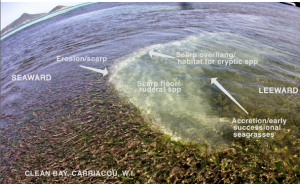
More about the blowouts
I wrote up one aspect of the descriptive stuff, on “blowouts” in the seagrass beds and published it in 1975. It has been perhaps my most cited paper. In 1993 I had a call out of the blue, when the Director of McGill’s Bellairs Research Institute in Barbados asked me in a heavy West Indian accent “Patriquin, when are you coming back to work on the seagrasses beds?” He knew about the surveys I had done and wanted to see them repeated. (There would be no equivalent long term dataset.) I said, Wayne, I can do it only if you buy out my winter teaching, and to my surprise he did. So in early 1994, I returned to repeat the surveys of 1969… I got it 95% written up for publication but, for various reasons, I couldn’t get the time to finish it over the next 10 years. I felt pretty bad about it because of the investment made in supporting the research (the project also involved a PhD research project which I would supervise, and that did go to completion). After 10 years (2004), it was kind of late to publish.. (an old study), so I thought I will do it again after I retire and then it will be current again.
I retired in 2008…only in 2015 did I make a stab at it and went back to Barbados at the same time of year, in the winter months when the sea is normally calmer than in other periods and there is less rainfall causing turbidity. I was close to 46 years older than in 1969 and wasn’t sure if I could handle it physically. Ten days in the water did it. (Also, all of the respiratory afflictions that I generally experience from about Nov to April went away.) I felt 25 again, and finished the survey in Barbados in 2015, and in Carriacou in 2016. A colleague from Dal and still at Dal, Robert Scheibling, came for period each year to collaborate as he had in 1994 (Bob had conducted PhD research in Carriacou in the 1970s). We had our first paper published last year on a serendipitous aspect of the study, documenting the spread of an invasive seagrass first seen in the Caribbean in Grenada in 2002. Bob was lead author because it was based more on his historical surveys than mine and also involved Oreaster reticulatus, the big seastar you see in tourist shops (dead of course).
That left me to finally publish the main body of work which involves going back to notebooks from 1969, putting it all in digital form etc etc. and then running comparative analyses to look at differences over time. It’s been slow, but I got to 80% there for the Carriacou study this fall, with one issue – I realized that one of the transects we conducted in 2016 was about 175 meters from where it should have been, and it makes a difference in this case because of reefs close-by. It’s also a critical transect. It’s also at the site that was the most challenging due to remoteness and wave action; in 1969 sharks were also an issue (not later because they were largely fished out) and a moray eel bit a finger down to the bone in 1969. Regardless, I have to go back to get the correct transect. That will take about 10 days, but I will stay at Barbados until mid-April to follow up on some coral reef observations there and to work on the seagrass data with few things to distract me – and just to do a lot of swimming and paddling and try to feel 25 again. (Even if I do, after I get back to NS, the pains of gravity , moisture, cold or whatever return quickly to my 75+ old body.)
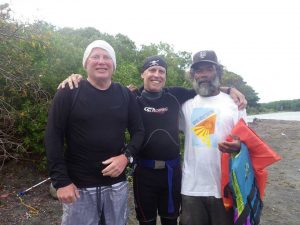
Covered up in Carriacou in 2016.. Irwin at right was our boat man; he is a brother of CoyCoy who had been my assistant in 1969 and helped us again in 1994. The Carriacou people are sailors and ship-builders. When I looked for CoyCoy in 1994, I found him building a 47 ft wooded schooner with hand tools and no plans. There are connections between Carriacou & Lunenburg.. common ship-building skills, and trade going back a way (salted cod going south, rhum going north).
My spouse, who has been my helper in more ways than one through all of this is pretty happy about it. We met and got married within 6 weeks in 1967 and a few weeks later left to Barbados for 3 years and we are still together. (Barbados helped.) She is of Mediterranean origin and loves full exposure to the sun. I cover up almost completely. My son came as an able unpaid assistant in 1996.
I will have internet access..so nsforestnotes.ca won’t disappear altogether, but I certainly won’t try to keep up the fast and furious pace of the last several weeks. Hopefully I won’t lose sleep over forestry issues for a while either!
I am not sure why I thought it pertinent to tell this story. I began by writing a very simple explanation but found it “didn’t work”.
There is some connection to my interests in forests which has to do with some similarity in process between the dynamics of the blowouts I am studying in seagrass beds, and “pit and mound topography” in old forests of Nova Scotia. I have developed a strong interest in that topic from the instant I learned about them in some detail at the MTRI Old Forest Conference in the fall of 2016…(which also saw some of the protagonists together because of mutual interests in forest ecology). It would be too too much of a diversion to explain here the connection between seagrasses and pit and mound topography.

Click here for the story up to 1996
Thinking about it, I realized another connection and it’s a lot of what drives my concerns about our impacts on the natural world: I had revelled in healthy reefs in 1969, and saw their decline following the massive die off of a key reef building coral in the early 1980s and further degradation associated pollution, coral bleaching etc. One question I am looking at in the seagrass research: how has massive degradation of those barrier reefs in Carriacou affected the seagrasses behind the reefs.
I guess the main reason I am blurting this all out is because I have some apprehension that some people on both sides of the debates may think “he doesn’t really give a s__t”, that I am not a real environmentalist because I am abandoning the cause and generating too much CO2 in the process (flying), or that I am one of the small group of “professional protesters” stirring up trouble in NS for whatever; and to answer the question I am told some DNR staff asked about 2 years ago after I started writing this blog and sending missives to Ministers etc., which was who is this guy anyway? It’s an understandable question as I am an academic but have no formal qualifications in forest ecology or forestry and haven’t published in the area (except for a couple of tangential papers on which I am a co-author, one to do with nitrogen fixation and the other with the concept of Ecological Integrity).
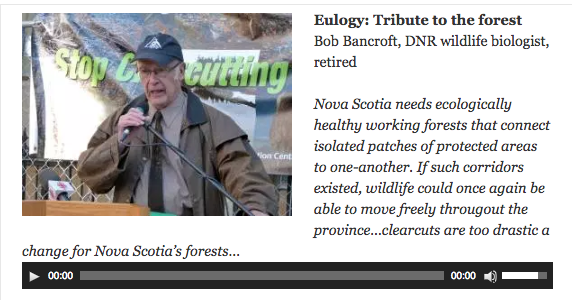
Professional Protester– or is it a Professional who is protesting? Source
So I hope I have answered that question.
I have a great deal of respect for many people on both sides of these debates and try to understand their positions and when possible to discuss them directly whether on social media or over a coffee. I also have some reservations about some people on both sides but I think we all need to be talking.
——————————————————————————————————-
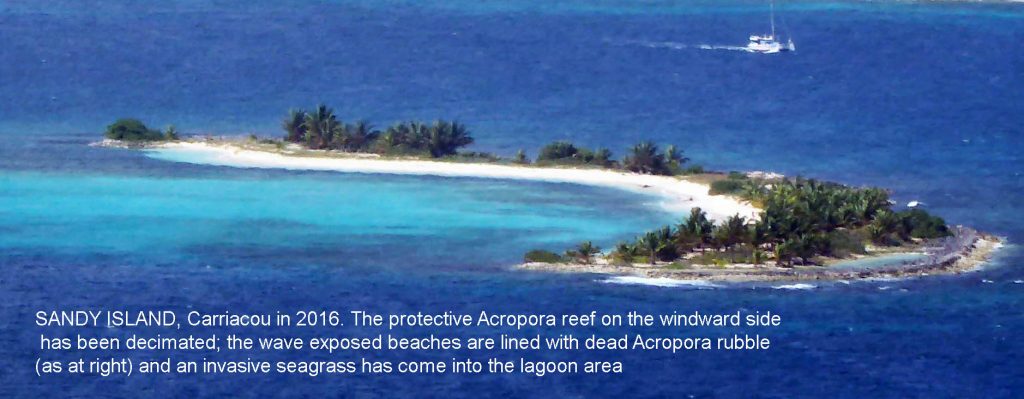 Continuing from the script on the photo…The turning point was the abrupt die-off of Acropora palmata (reef-building coral) in the 1980s. Complete degradation of the protective framework which was maintained for a while even though not being renewed by new coral growth, took another 30 years. Could the intensive clearcutting now occurring in NS have similar consequences (including proliferation of invasive species) only to be fully realized and unequivocally acknowledged by all several or more decades from now?
Continuing from the script on the photo…The turning point was the abrupt die-off of Acropora palmata (reef-building coral) in the 1980s. Complete degradation of the protective framework which was maintained for a while even though not being renewed by new coral growth, took another 30 years. Could the intensive clearcutting now occurring in NS have similar consequences (including proliferation of invasive species) only to be fully realized and unequivocally acknowledged by all several or more decades from now?
A kind of P.S.
A lot of people say “you must spend all of your time on NSFN”. I don’t, although there has been too much of it recently. I do this stuff very quickly as I “got into” web stuff in 1998 when I figured I could use it in teaching… that was a diversion that took me away for the rest of my tenure at Dal from a lot the research I had been doing, but I haven’t regretted it. We need scientific publication, peer review etc; all that stuff is essential. But we also need to see academics communicating in social media. It’s happening.. expect to see some more Professionals who will Protest about forestry in NS, but will also seek solutions and rapprochement.
A final thought. back in June I wrote the following as an intro to In the News:
Beginning today, June 11, 2018, this page will provide a list of links to news and some social media posts related to forests and forestry in Nova Scotia, the most recent items at the top, as I access them.
Some will also be listed under Independent Review, and some may also be the subject of a post on the Home Page.
Up to this point I have attempted to provide a post on the home page about every news item; all posts are listed under About this site>All Posts. However, I have found that I am missing more and more as at times I can’t keep up with it all, not-to-mention that outdoor Nova Scotia is just too enticing at times…
With the ballooning discussion of forestry issues on social media and heavy press coverage of North Pulp, etc I have again got to times I can’t keep up with it all, and as above, I will have to figure out a way of still keeping relevant and timely, but with less effort. That’s something I learned to do after three serious burnouts, one when completing my PhD, one midway through my career at Dal, and one in retirement. That’s three strikes and I should be out (maybe the last one was a foul ball). I def cannot afford the risk of taking another swing without hitting the ball. Most of us learn that sooner or later, or don’t and then there be no “later”. I guess as an Old Guy I can kind of suggest to those much younger than I or even of my age, on both sides, that they take a similar approach. It might also help to reduce the temperature a bit, while not losing our resolve to fix things, and get us there faster.
Apologies if I am lecturing. One reason I got into interactive web based teaching was that I had become tired of hearing my own voice and I wanted to hear more from the students. In one class I taught web skills to students to enable them to communicate between classes, and used the lecture time as a “talking classroom’ all driven by 7 groups of 5. Before the class I gave the students a problem to solve, and that’s what they did – in groups and I responded to questions etc. and students (not me) were very talkative. I developed a large introductory class as a totally online class, but involving a lot of interaction between students and between students and TAs.
And as I said, I am an Old Guy – but hopefully society can remain tolerant of old people, even if we aren’t too tolerant of of old trees.
Damn, I can’t shut up. Time to stop.

